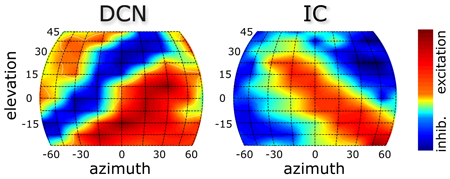Auditory Processing of Sound Localization Cues
Sound localization experiments in humans have revealed that there are three main physical cues o the location of a sound in external space; these are illustrated in the figure to the right. The first two cues arise as a result of the separation of the two ears in space, i.e., sound from one side of the head arrives at the farther ear delayed in time and attenuated in level with respect to that arriving at the nearer ear. These binaural cues are important for left-right (azimuthal) localization. The third cue, spectral information, is created by the filtering properties of the head and outer ear as auditory stimuli propagate to the eardrum. Spectral cues contribute to the resolution of front/back confusions when different sound sources create the same interaural cues, and are critical for accurate localization of elevation in the midline where interaural cues are presumed to reduce to zero.
Several lines of evidence suggest that the three main sound localization cues are processed in separate functional pathways in the brainstem. For example, it is thought that the dorsal cochlear nucleus (DCN) initiates a pathway specialized to process spectral notches, and that type O units in the inferior colliculus (IC), one of three major response types in the IC, represent the midbrain component of this pathway. Responses to virtual space stimuli of a representative DCN and IC unit are shown in Fig. 2 where excitatory responses for a stimulus in a particular location (azimuth and elevation) are shown in red and inhibitory responses are blue. Note that both unit types show a tuned diagonal feature in their spatial receptive fields which parallels the contours of notches in space; however, DCN units are inhibited by spectral notches, whereas IC units are excited. We are now performing experiments to investigate how all three sound localization cues are represented at various levels within the ascending auditory system and how the neural circuits are organized to create these representations.

Fig 2. Spatial receptive fields for DCN (left) and IC units (right); these units are in the spectral processing pathway. Note that both unit types show diagonal features in their maps (one is inhibited, whereas the other is excited) which parallel the contours of notches in space. Experiments are under way to investigate how the neural circuitry of the auditory system is organized to encode and transform the representation of all three sound localization cues.
Researcher: Kevin A. Davis, Ph.D.
Auditory neurophysiology, neural circuitry and information processing, and computational neuroscience.
